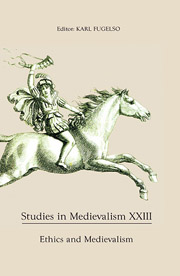Book contents
- Frontmatter
- Acknowledgments
- Contents
- List of Illustrations
- Epigraph
- Editorial Note
- I Ethics and Medievalism: Some Perspective(s)
- II Interpretations
- What if the Giants Returned to Albion for Vengeance? Crusade and the Mythic Other in the Knights of the Nine Expansion to The Elder Scrolls IV: Oblivion
- The Dark Ages of the Mind: Eugenics, Amnesia, and Historiography in Dan Brown's Inferno
- Plastic Pagans: Viking Human Sacrifice in Film and Television
- Meat Puzzles: Beowulf and Horror Film
- Words, Swords, and Truth: Competing Visions of Heroism in Beowulf on Screen
- Socialism and Translation: The Folks of William Morris's Beowulf
- “We Wol Sleen this False Traytor Deeth”: The Search for Immortality in Chaucer's Pardoner's Tale and J. K. Rowling's The Deathly Hallows
- Intention or Accident? Charles Alfred Stothard's Monumental Effigies of Great Britain
- Contributors
- Previously published volumes
Intention or Accident? Charles Alfred Stothard's Monumental Effigies of Great Britain
from II - Interpretations
Published online by Cambridge University Press: 05 May 2014
- Frontmatter
- Acknowledgments
- Contents
- List of Illustrations
- Epigraph
- Editorial Note
- I Ethics and Medievalism: Some Perspective(s)
- II Interpretations
- What if the Giants Returned to Albion for Vengeance? Crusade and the Mythic Other in the Knights of the Nine Expansion to The Elder Scrolls IV: Oblivion
- The Dark Ages of the Mind: Eugenics, Amnesia, and Historiography in Dan Brown's Inferno
- Plastic Pagans: Viking Human Sacrifice in Film and Television
- Meat Puzzles: Beowulf and Horror Film
- Words, Swords, and Truth: Competing Visions of Heroism in Beowulf on Screen
- Socialism and Translation: The Folks of William Morris's Beowulf
- “We Wol Sleen this False Traytor Deeth”: The Search for Immortality in Chaucer's Pardoner's Tale and J. K. Rowling's The Deathly Hallows
- Intention or Accident? Charles Alfred Stothard's Monumental Effigies of Great Britain
- Contributors
- Previously published volumes
Summary
Introduction
Charles Alfred Stothard's (d. 1821) Monumental Effigies of Great Britain contains some of the finest etchings of medieval tomb-effigies ever published. The superb quality of the prints, and the fidelity with which they were thought to represent the medieval effigies Stothard depicted, guaranteed the book's reputation throughout the nineteenth century.
In the last forty years, several major studies have stressed the book's great cultural significance in the early phases of the Gothic Revival. They have also highlighted its visual distinctiveness. Stothard's etchings have always been renowned for their intense artistic focus on the effigies alone. This concentration contrasts with the approach of most earlier British antiquarian draughtsmen, who usually showed the whole monument — that is to say the effigy within its architectural setting — even if they also included separate plates of the effigy by itself. Stothard's very different artistic emphasis has been attributed to his training in the Royal Academy Schools. However, it has also, more contentiously, been argued that he deliberately suppressed any visual evidence of the architectural contexts — the tomb-chests, canopies, or architectural settings — in which the effigies belonged. The reason he did this, it is alleged, is because he felt uneasy, as a nationalistic Protestant Englishman, about showing the medieval Roman Catholic contexts in which the effigies belonged. So, he edited them out.
This article forensically investigates why the effigies' original architectural environments should have been omitted from Stothard's prints. The results of this investigation are very surprising.
- Type
- Chapter
- Information
- Studies in Medievalism XXIIIEthics and Medievalism, pp. 205 - 242Publisher: Boydell & BrewerPrint publication year: 2014



